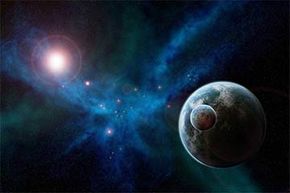We in our snug little solar system can be forgiven for thinking that everything revolves around our sun. (Mostly because everything in our own little corner of the universe does, in fact, revolve around the sun.) But does that mean that every planet in the universe needs a warm body to snuggle up to? Can a planet just wander aimlessly through the universe without a star to orbit?
Absolutely. But you might be surprised to find that planets can exist in several other iterations, too. They can orbit dead stars, for one, or might fly through the universe at extraordinary speeds thanks to a kind of cosmic slingshot event. But before we get to our free-wheelin' planet cousins, let's give a little background on how stars usually support planets.
Advertisement
For one, stars and planets are usually formed from the same mess of matter. When a nebula (a big cloud of gas and dust) collapses, the core forms a hot star. The outer disk begins to form planets, as matter sticks together in an orbit around the core [source: HubbleSite]. Matter either collides with the infant planets or sticks to them, so that in time the orbit becomes an HOV lane: free and clear for the planet to travel.
We're not quite certain how planets form without stars. But scientists do know that some wandering planets without a sun (also called runaway planets) broke away from their star after birth. Some of these planets are actually catapulting through the universe at nearly 30 million miles (48 million kilometers) per hour [source: Harvard-Smithsonian]!
So what happens when a planet doesn't have a star to guide the way? These superfast planets (called hypervelocity planets) are produced the same way as hypervelocity stars. When a double-star system gets too close to a black hole one of the stars is consumed while the other is sent shooting through the universe. While the planets of a catapulted sun might follow it and continue orbiting, the black-hole sun's planets might just be shot out of their orbit [source: Harvard-Smithsonian].
Nearby gas giants can also cause planets to careen out of solar orbit and plunge into space. Two University of Chicago scientists researched whether a planet dramatically ripped from its solar system and sent forth into the frigid atmosphere of open space could still harbor life under frozen oceans. Their findings? A planet three or four times bigger than Earth could have enough heat to keep an ocean liquid under an icy surface a few kilometers thick; the ocean could last billions of years. The type of life sustained, though, would almost certainly be microscopic organisms [source: Grossman].
Advertisement
